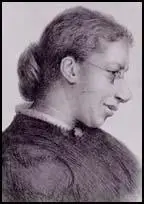Helen Blackburn

Helen Blackburn, the daughter of a civil engineer, was born on Valentia Island, off the south-west coast of Ireland, in 1842. A talented artist, she had to give up by the age of 21 because of deteriorated eyesight.
In 1872 she joined the Central Society for Women's Suffrage. By 1874 she became secretary of the executive committee of the organisation. She also became a regular contributor and eventual editor of the Englishwoman's Review.
Blackburn became secretary of the Bristol and West of England Suffrage Society and in 1880 organised a large demonstration in Bristol in favour of women's suffrage. During this period she was described by Frances Balfour as an important figure in the struggle for the vote: "On the table amid her work was a small glass, in which stood a single flower, or sprig of green, and not infrequently a little bit of shamrock, in strange outward contrast to the large uncouth figure of Miss Blackburn, her shortsighted eyes always close to the papers she was working at... Her face was greatly marred by long illness, most patiently borne, but through its plainness there shone the countenance of a great soul.... Miss Blackburn was a born chronicler and antiquarian.. Her knowledge and experience was at everyone's disposal."
As Elizabeth Crawford, the author of The Suffragette Movement (1999), has pointed out: "Helen Blackburn was a strenuous opponent of legislative restrictions on the labour of women, and contended that what women wanted were more and not fewer opportunities of earning their living." In 1885 she joined Jessie Boucherett in forming the Labour Defence Association to protect workers from restrictive legislation.
In 1887 seventeen of these individual groups joined together to form the National Union of Women's Suffrage Societies (NUWSS). Lydia Becker was elected as president. Three years later, when Becker died, Millicent Fawcett became the new leader of the organisation. Blackburn was a leading figure in the NUWSS until 1895 when she retired from active duty to look after her aged father.
Blackburn now concentrated on her research and joined with Jessie Boucherett to write, The Condition of Working Women (1896). In 1902 she published Women's Suffrage: A Record of the Women's Suffrage Movement in the British Isles.
Helen Blackburn died in 1903.
Primary Sources
(1) Frances Balfour, Me Obliviscaris (1930)
On the table amid her work was a small glass, in which stood a single flower, or sprig of green, and not infrequently a little bit of shamrock, in strange outward contrast to the large uncouth figure of Miss Blackburn, her shortsighted eyes always close to the papers she was working at... Her face was greatly marred by long illness, most patiently borne, but through its plainness there shone the countenance of a great soul.... Miss Blackburn was a born chronicler and antiquarian... Her knowledge and experience was at everyone's disposal.
